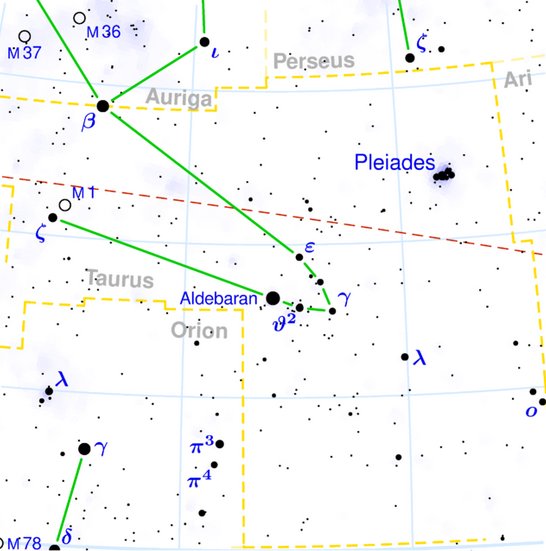My updated beginning of line Ga1 needs to be presented, because other phenomena emerge:
In rongorongo times γ Tauri, the star which once marked the origin of the summer year, rose with the Sun in May 24 (144). Its Greek letter gamma (Phoenician gimel) may well have been chosen because its form looked like the diverging paths of the horns on the head of the Bull:
What would the new year bring? Would it repay all the efforts of keeping the agricultural fields in good shape or would there be punishment for not weeding enough? In the time of Al Sharatain the date for heliacal γ Tauri was 27 days earlier than in rongorongo times, viz. in day 117 = 144 - 27. According to our Gregorian calendar this would have been in 'April 27 (as if underlining how important it was to remember 27). Thinking similarly as regards May 24 it could symbolize the final of the old year (24 like the hour of midnight) and as a reminder of where once the Bull broke through at 0h (= 24h). Then I discovered (and documented in my presentation of the glyph text above) the remarkable fact that when 'April 27 is written 4-27 and read as 427 it becomes the product of 7 and 61 (= 366 / 6). Remarkable because the same star position in the time of Bharani was "April 13 = 4-13 = 413 = 7 * 59 (where 59 = 354 / 12). It seems probable that the adjustments of the Julian calendar by the experts of Gregory XIII cleverly made these dates into 'memorials': ... When Julius Caesar established his calendar in 45 BC he set March 25 as the spring equinox. Since a Julian year (365.25 days) is slightly longer than an actual year the calendar drifted with respect to the equinox, such that the equinox was occurring on about 21 March in AD 300 and by AD 1500 it had reached 11 March. This drift induced Pope Gregory XIII to create a modern Gregorian calendar. The Pope wanted to restore the edicts concerning the date of Easter of the Council of Nicaea of AD 325. (Incidentally, the date of Easter itself is fixed by an approximation of lunar cycles used in the Hebraic calendar, but according to the historian Bede the English name 'Easter' comes from a pagan celebration by the Germanic tribes of the vernal - spring - equinox.) So the shift in the date of the equinox that occurred between the 4th and the 16th centuries was annulled with the Gregorian calendar, but nothing was done for the first four centuries of the Julian calendar. The days of 29 February of the years AD 100, AD 200, AD 300, and the day created by the irregular application of leap years between the assassination of Caesar and the decree of Augustus re-arranging the calendar in AD 8, remained in effect. This moved the equinox four days earlier than in Caesar's time ... Gregory dropped 10 days to bring the calendar back into synchronisation with the seasons. Accordingly, when the new calendar was put in use, the error accumulated in the 13 centuries since the Council of Nicaea was corrected by a deletion of ten days. The Julian calendar day Thursday, 4 October 1582 was followed by the first day of the Gregorian calendar, Friday, 15 October 1582 (the cycle of weekdays was not affected). Furthermore, it is not inconceivable that the experts of Gregory XIII also saw into the future and decided to make November 25 around 1842 A.D. as the final before next calendar had to be created. Remarkably I here discovered that A.D. 1582 + 260 (= 26000 / 100) = 1842 A.D. A coincidence or not? November 25 should be read as 9-25 and counted as 92 * 5 = 460, and this number was connected with heliacal Bharani, because 414 (as in its RA 41.4 in rongorongo times) could be encoded as "April 14 (= "March 21 + 24 days). This was 3 days earlier than "April 17 (107) = day 104 (twice 52). 460 could point at the 'antipode' of November 25, viz. May 25, because in rongorongo times this was where γ Tauri rose with the Sun. Number 46 was certainly important for the rongorongo writers:
In rongorongo times the star in front of summer south of the equator (Ana-mua, Antares) rose with the Sun in November 25 (329) and this was 249 days after 0h. 24 * 9 = 216 = 8 * 27. In the time of Bharani Antares rose with the Sun in "October 15 and in A.D. 1582 the Gregorian calendar had been born in October 15. The pattern formed by all such facts can hardly be due to a bunch of coincidences. | ||||||||||||||||||||||||||||||||||||||||||||||||||||||||||||||||||||||||||||||||||||||||||||||||||||||||||||||||||||||||||||



